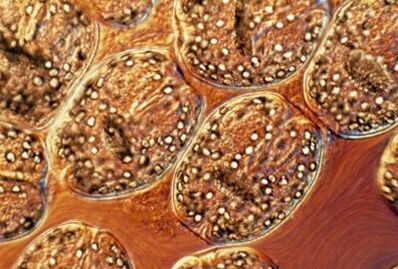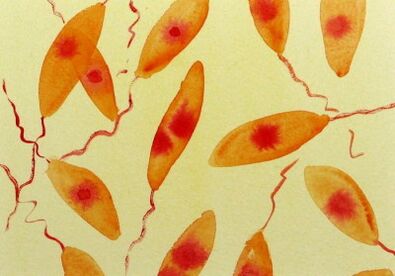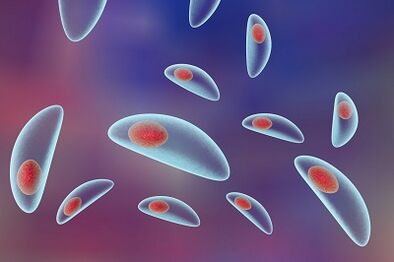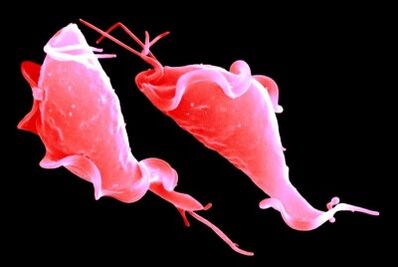
The simplest parasite is an organism that is adapted to invade and live in the cells and tissues of other organisms. The simplest parasites, like other protozoa, cannot live alone in an open environment, but have to invade the body of another organism for protection and nourishment.
The simplest parasites and their varieties
The simplest organisms are eukaryotic systems that exist as structurally and functionally independent single cells (including those species that are gregarious or form colonies). Protozoa develop relatively complex subcellular features (membranes and organelles) that enable them to survive in harsh environmental conditions. Most protozoa are microscopic organisms, and few of them grow large enough to be visible to the naked eye. As unicellular eukaryotes, they move around to survive, feed and reproduce.
There are some of the simplest parasites that cause problems. They are present in our food, soil and water and can make us very sick if they ever invade us.
Every single protozoal parasite can cause various diseases in our body. Some of them can cause serious respiratory problems (the passage of air from the nose to the lungs) and central nervous system (brain, cranial nerves, and spinal cord), others live in the intestines and cause symptoms such as diarrhea and are not fatal.

There are four types of protozoal parasites classified according to their movement:
- Sarcodes are a group of amoebas that move with pseudopods and contractions that change the shape of their cells;
- Mastigophores move with the help of flagella;
- Siliophores use cilia;
- Sporozoa are immobile when they are mature.
Life cycles of protozoal parasites
Most protozoa have enormous reproductive potential because they have a short generation time, undergo rapid sequential development, and produce large numbers of offspring of an asexual or sexual species. These properties are responsible for many of the simplest infections that quickly cause acute symptoms of the disease.
The developmental stages of protozoal parasites found within the host usually consist of ingestion of trophozoites and can be found intracellular (in the host's cells) or extracellular (in hollow organs, body fluids, or internodes between cells). Although trophozoites are ideal because of their parasitic mode of existence, they are not very resistant to external environmental conditions and do not survive long outside their hosts. To get from host to host, protozoal parasites use one of four main routes of transmission: direct, fecal-oral, transmissible, and predator to prey.
Pathways of transmission from protozoal parasites to humans
- Direct transmission of parasites through intimate contact with the body - sexually (for example, Trichomonas spake fungi, which cause trichomoniasis in humans).
- Faecal-oral transmission of ecologically stable cyst stages - parasites enter with the feces of one host and are transmitted to another with food or water (e. g. dysentery, giardiasis, and balantidiosis).
- Transmission occurs when parasites are ingested by blood-sucking arthropods (insects or arachnids) and transmitted to new hosts through a bite (e. g. , causing malaria).
- Transmission from predator to prey occurs when the simplest parasite gets stuck in the victim's tissues (for example, a cow, goat, pig) and is eaten by a predator (in our case, a person).
The simplest human parasites and the diseases that cause them
Acanthamoeba. This parasite infects a person's eyes or brain, causing exogenous amebiasis. He can live in any region of the world. People can get it by washing contact lenses with tap water.
Babesia. It infects red blood cells and causes a disease called babesiosis. Different types of parasites live in different parts of the world. It is transmitted by ticks when they are bitten.

Balantidium (Balantidium coli). Lives in the intestinal mucosa, causes dysentery, also called balantidiosis.
Blastocystis (blastocystis). This parasite infects the host's intestines. It enters humans through ingested food that is contaminated with human or animal feces. The disease caused by this parasite is called blastocytosis.
Cryptosporidium (Cryptosporidium). Lives in the human intestine. Distributed all over the world. It enters the human body through ingested food that is contaminated with human or animal feces.

Dysentery amoeba (Entamoeba histolytica). This simplest parasite causes intestinal amebiasis. Most commonly found in densely populated areas, poor sanitation, and tropical regions. It is transmitted fecal-orally.
Giardia lamblia. Lives in the lumen of the small intestine. When people consume food or water contaminated with feces, dormant Giardia cysts can infect the body and cause intestinal giardiasis. It is especially dangerous for children and requires mandatory compliance with the treatment regimen.
Isospores (Isospora belli). Affects the epithelial cells of the small intestine. Distributed all over the world. It is transmitted faecal-orally and is the causative agent of isospore.
Leishmania. Parasitizes a person's skin and internal organs. It exists in various forms around the world. Is transmitted by some species of mosquito when bitten.

Negleria (Naegleria fowleri). Causes primary amoebic meningoencephalitis as it lives in the human brain. Contagion occurs through contaminated soil, swimming pools and contaminated water.
Plasmodium (Plasmodium falciparum, P. vivax, P. ovale, P. malariae). Parasites invade red blood cells and cause malaria. They occur in tropical regions where Anopheles, also known as the Anopheles mosquito, are distributed.
Rhinosporidium seeberi. It multiplies in the nose and nasopharynx and grows there in the form of spores. It exists in India and Sri Lanka. People who swim in public waters can become infected with the parasite if their nasal mucosa comes into contact with contaminated material.

Toxoplasma (Toxoplasma gondii). Affects the liver, heart, eyes and brain. A parasite that is common around the world. People can become infected after consuming raw or undercooked pork, lamb, goat, or milk. Can also be found in contaminated food or soil through cat feces. The disease caused by this parasite is called toxoplasmosis, or parasitic pneumonia.
Trichomonas (Trichomonas vaginalis). It infects the female urogenital tract. Symptoms differ in men and women. It is the causative agent of trichomoniasis, a sexually transmitted infection.

Trypanosomes (Trypanosoma brucei, Trypanosoma cruzi). The first type of parasite affects the central nervous system, blood and lymph. It is transmitted by the tsetse fly and causes what is known as sleeping sickness. The second parasite causes Chagas disease by affecting the blood, muscles, nerves, heart, esophagus, and intestines. Also transmitted through insect bites.
How to treat infections caused by protozoal parasites in humans?
The treatment plan for protozoal parasite infection depends on the specific diagnosis. Your doctor will usually prescribe medication, for example to treat trichomoniasis, giardiasis, or cryptosporidiosis. Usually, drugs for toxoplasmosis are not prescribed unless there are conditions such as pregnancy, other illness, or severe and persistent infection.
The doctor may also recommend other treatments to help relieve symptoms. For example, many parasitic infections can cause diarrhea, which often leads to dehydration. Therefore, when treating an infection caused by protozoal parasites, it is usually recommended to drink plenty of fluids to make up for the loss in the body.
How can protozoan parasites be prevented?
There are several steps you can take to reduce your risk of parasitic infection:
- practice safe sex with a condom;
- Wash your hands regularly, especially after handling raw food or feces;
- Cook food to the recommended core temperature.
- drink clean water, including bottled water, when you travel;
- Avoid swallowing water from lakes, streams, or ponds;
- Avoid cat litter and feces during pregnancy.
If you suspect you may have a parasitic infection, make an appointment with your doctor. They can help diagnose the cause of your symptoms and recommend a treatment plan. The sooner you start treatment, the sooner you can help stop the infection from spreading to others.





























